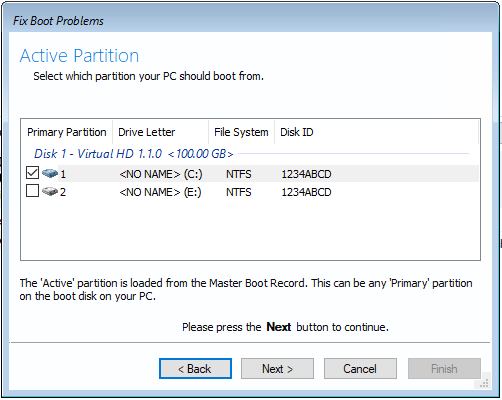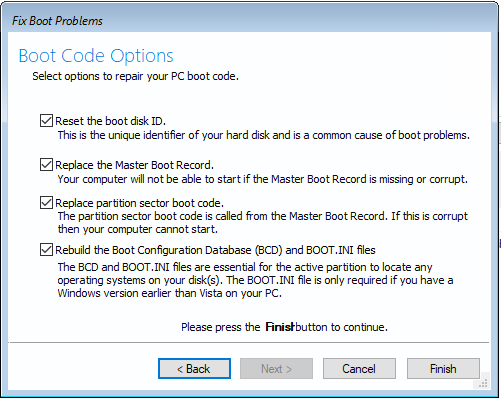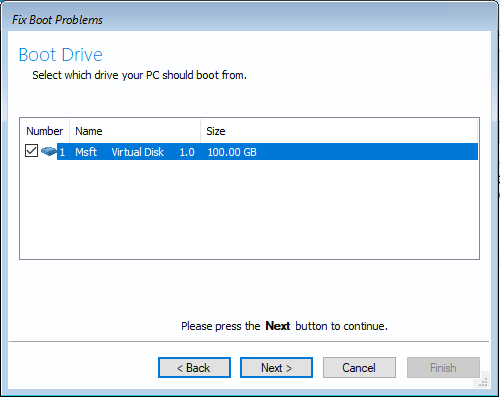- Overview
- Fix Boot Problems for MBR/BIOS Systems
- Fix Boot Problems for GPT/UEFI Systems
Overview
When restoring a system image or cloning a disk, there are situations where Windows may be unable to boot due to incorrect boot configuration data. To troubleshoot these errors, Macrium Reflect rescue media includes a utility called 'Fix Windows boot problems'.
The steps that 'Fix Windows boot problems' performs will vary depending on whether the disk, where the operating system is located, uses the MBR or GPT partition scheme.
Fix Boot Problems for MBR/BIOS Systems
'Fix Windows boot problems' can be run from within the Macrium Reflect rescue media. Some systems can boot in both legacy (CSM) mode and EFI mode. When using 'Fix Windows boot problems' on an operating system on an MBR disk, the system should be booted in legacy (sometimes called CSM) mode.
To ensure that the rescue media has booted in the correct mode, check the top bezel. If '[UEFI]' is shown, then the rescue media has booted in EFI mode. If '[UEFI]' is not shown, then the rescue media has been legacy booted.
EFI boot mode:
![]()
Legacy boot mode:
![]()
Once the rescue media has been booted in the correct mode, 'Fix Windows boot problems' can be run under the 'Existing Backup Tasks' menu on the 'Existing Backups' tab:

In the 'Fix Boot Problems' wizard, a list of detected Windows installs will be displayed. If the wizard has not automatically detected the target Windows install, a Windows install can be added using the 'Add' button on the right-hand side of the wizard:

On the second page of the wizard, specify the partition that will be marked as the active partition, essentially, the partition that the system will boot from. The wizard automatically selects the boot disk for the relevant Windows install, but this can be changed if an alternate configuration is required:

The final page enables the behavior of 'Fix Windows boot problems' to be configured, by selecting exactly what will be repaired. For the majority of use cases, we recommend proceeding with the default selection, unless directed otherwise by Macrium support:

Select 'Finish' and 'Fix Windows boot problems' will run.
Once 'Fix Windows boot problems' has completed, a prompt to restart will be displayed. If a physical rescue media is being used, remove the media and attempt to boot into the Windows operating system again.
Fix Boot Problems for GPT/UEFI Systems
'Fix Windows boot problems' can be run from within the Macrium Reflect rescue media. Some systems can boot in both legacy (CSM) mode and EFI mode. When using 'Fix Windows boot problems' on an operating system on a GPT disk, the system should be booted in EFI mode.
To ensure that the rescue media has booted in the correct mode, check the top bezel. If '[UEFI]' is shown, then the rescue media has booted in EFI mode. If '[UEFI]' is not shown, then the rescue media has been legacy booted.
EFI boot mode:
![]()
Legacy boot mode:
![]()
Once the rescue media has been booted in the correct mode, 'Fix Windows boot problems' can be run under the 'Existing Backup Tasks' menu on the 'Existing Backups' tab:

In the 'Fix Boot Problems' wizard, a list of detected Windows installs will be displayed. If the wizard has not automatically detected the target Windows install, a Windows install can be added using the 'Add' button on the right-hand side of the wizard:

(Optional Step) If the system has multiple disks, an additional page may be displayed, prompting to select which disk should be used to boot from. Select the disk that will be used to boot from, then select 'Next'.

The final page of the wizard will display a summary of the options specified on the previous pages. Once the summary has been reviewed, select 'Finish'.

Once 'Fix Windows boot problems' has completed, a prompt to restart will be displayed. If a physical rescue media is being used, remove the media and attempt to boot into the Windows operating system again.
Video Tutorial